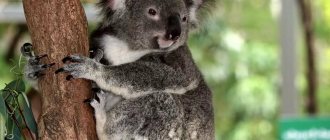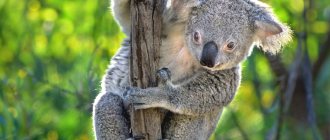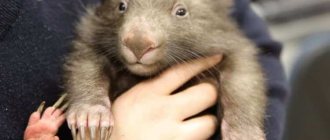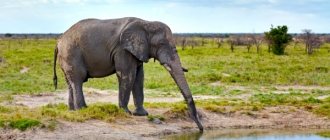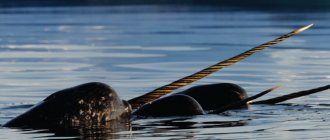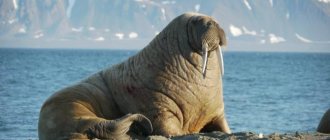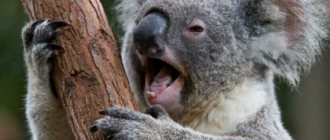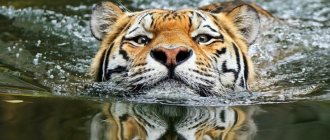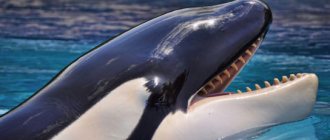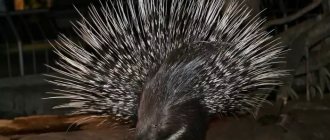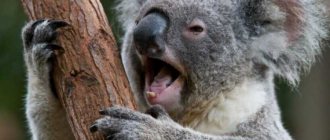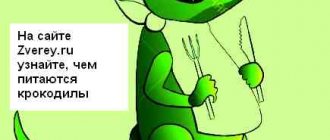Description, structure, characteristics
Although the koala is called a marsupial bear, or an Australian bear, due to some external similarity, it has nothing to do with real bears; the koala and the bear are not even distant relatives. The koala belongs to the family of marsupials, which is represented by three species: koalas themselves, wombats and kangaroos. The wombat is the closest relative of the koala.
The appearance of the koala is very unusual. Its fur is short and thick, usually gray, smoky in color, but there are koalas with brown shades. But her belly is always white.
The body length of the koala is 60-85 cm, with a weight of up to 14 kg.
The koala's eyes are small and blind, vision is not its greatest advantage, but the koala's weak vision is fully compensated by its excellent hearing and sense of smell. The koala's large ears are located at the edges of its head and are also covered with fur. The koala also has a large flattened black nose.
Koala teeth are ideal for eating plants; however, all marsupials, including wombats, these closest relatives of koalas, have a similar tooth structure.
And since koalas live mainly in trees, nature gave them tenacious front paws with long claws (promoting tenacity). Each koala's front paw has two double-phalangeal thumbs and three standard three-phalangeal toes. The hind legs are arranged differently - on the koala’s foot there is only one big toe, which is devoid of nails, and four ordinary toes. Thanks to their tenacious front paws, koalas easily cling to tree branches and in this position they dine, rest and even sleep.
Does a koala have a tail? Yes, there is, but only the koala's tail is so short that it is practically invisible under the fur.
Body Features
Koalas have very interesting fur, which is valued all over the world, this, by the way, is one of the reasons why they were previously hunted on a large scale. When it rains, it repels moisture, so they practically don’t get wet. The thick undercoat remains completely dry. On hot days, when the sun inexorably burns everything around, the fur serves as a kind of cloak, preventing the rays from scorching the delicate skin of the animal.
In addition to their fur, koalas are famous for their claws. Unlike primates and humans, they have two fingers protruding to the side. When climbing trees, this feature allows you to securely hold onto branches without slipping or slipping. During sleep or in moments of rest, when she just needs to sit still, the koala clasps her fingers into a kind of lock around branches or a tree, which does not fall apart even in an unconscious sleepy state, thanks to which koalas never fall.
History of the discovery of koalas
Interestingly, the discoverer of Australia, the famous English navigator James Cook, never discovered koalas, despite the fact that there were plenty of koalas at his landing site. Well, Captain Cook was just unlucky to meet them. And the first European to see these unique animals with his own eyes was the English naval officer Barallier. In 1820 he sent
the preserved body of a dead koala to the governor of New South Wales; a year later, a live koala was caught for the first time. Since then, this unique animal has become the subject of passion and research of many European zoologists.
Nutrition
What do koalas eat? All of them are herbivorous vegetarians, and their main source of food is shoots and
eucalyptus leaves. Interestingly, koalas have practically no food competitors, since eucalyptus leaves, which contain little protein and also contain hydrocyanic acid, are not interesting for other herbivores. But even among eucalyptus trees, not all leaves and shoots are suitable for food for koalas; thanks to their well-developed sense of smell, they are able to select the least toxic among them. In general, according to zoologists, koalas eat only 120 species of eucalyptus out of 800 found in nature.
A koala eats from 0.5 to 1.1 kg of leaves per day, and this is relatively little, but since all koalas are phlegmatic and inactive, this is enough for them. Also, sometimes they can eat ordinary soil, thus they compensate for the lack of certain minerals in the body.
As for the name of the koala - “non-drinker”, to some extent it is justified, since all marsupials consume very little moisture; koalas usually need morning dew that settles on the leaves and the moisture present in eucalyptus leaves to quench their thirst . But during periods of illness or drought, koalas can drink water from various fresh sources, as all other animals do.
There are fingerprints
0
We all know about human-monkey matches, human-pig matches, etc., but perhaps you haven't heard of human-koala matches before. Now you find out that an Australian resident and a person have similar fingerprints. Each animal has its own unique pattern on the “sole of the hand.” These cute marsupials are somewhat similar to humans - of course, they lag behind in terms of intelligence, and we have different food preferences. However, fingerprints are what unites us. If you look at them under a microscope, you will not find any differences... Moreover, in 1996, thanks to this discovery, scientists suggested that vortices and lines increase the tenacity of the limbs.
Lifestyle
All koalas are nocturnal; during the day they sleep peacefully on branches, and at night they climb these same branches in search of food. In general, these are very calm, good-natured, phlegmatic animals, leading a solitary, one might even say hermit, life. Koalas unite only for reproduction, and so they prefer to live separately, each koala has its own territory, and if the boundaries of this territory are violated by another koala, then the peacefulness of the koala can be replaced by aggressive behavior.
But koalas are usually friendly to people and are easily tamed. Now in Australia there are many koala nurseries where you can easily pet a koala, even pick it up.
When frightened, they make a sound similar to a child's cry.
It is better not to scare the koala again, because this amazing and cute animal makes a sound reminiscent of the cry of a small child ... It cannot leave anyone indifferent. A wounded or frightened koala cries, but usually this animal does not make any sounds and prefers to remain silent most of the time.
At the age of one year, a koala can begin to lead an independent life, but if its mother leaves it before that, the animal will cry because it is very attached to her.
Interesting fact: there is a video on the Internet in which a koala squeaks loudly and cries, it seems that the animal is shedding tears of bitterness. An incident that touched the entire Internet occurred in Australia - a male threw a small koala from a tree and even bit it a little. We don't know why he did it, but the poor baby started crying. What’s interesting is that only the males roar loudly.
Enemies in nature
In natural conditions, koalas have practically no enemies, since even wild dogs, dingoes, these Australian predators generally avoid koalas because of their bright eucalyptus scent. But human activity has had a very detrimental effect on their population, recently
Highways are increasingly cutting through the Australian eucalyptus forests, the patrimony of koalas, and often the clumsy and slow koalas die under the wheels of cars.
Population and protection of the species
The koala is listed in the Red Book with the status of a species under threat of destruction. The total number of animals, according to various estimates, varies from 100,000 to 200,000 individuals.
The main threats to the population are:
Diseases
Animals suffer from the KoRV immunodeficiency virus, which acts similar to human HIV. Northern populations are almost completely infected with it, while animals in southern Australia are still free from this virus.
Forest fires
The animals are very slow, and when there is a fire, the animals instinctively climb up the trunk. In addition, eucalyptus trees are highly flammable, so forest fires cause enormous harm to the population. During bushfires in the summer of 2019-2020 in New South Wales, about 8,400 animals died, this is about 30% of the state's population. About 30,000 koalas died in the Kangaroo Island fires, out of a total population of about 50,000.
Droughts
During drought, eucalyptus leaves fall and animals suffer from hunger, dehydration and overheating. Mostly young koalas die, as older and stronger individuals push the young away from sources of food and water. In 1980, due to an abnormally severe drought in Queensland, 63% of the population died. The number of animals in Queensland later declined even further, from 59,000 animals in 1995 to 11,600 animals in 2009, due to several abnormally dry seasons in 2002-2007.
Climate change
Global warming means a drier, hotter climate in Australia, which means bushfires, drought, hunger and thirst for koalas. Over time, the habitat of the animals will shrink even further, and the animals will remain only in areas with a more temperate climate. In addition, an increase in carbon dioxide in the atmosphere changes the composition of eucalyptus leaves: the protein content decreases, the tannin concentration increases, so the leaves become less nutritious.
Range reduction and fragmentation
Urbanization, expansion of agricultural land, deforestation and road construction are reducing and fragmenting the animal's natural habitat.
Australian Aborigines hunted animals for meat, but within reasonable limits. At the beginning of the 20th century, European settlers massacred the animals for their thick, beautiful fur. In 1924 Australia exported more than 2 million skins. In 1915, 1917 and 1919, more than 1 million animals were killed per year. Since the 1930s, Australians have been thinking about protecting the species, after only 500-1000 individuals remained in Victoria in 1934.
To preserve the population, Australians have opened new national parks, and regularly release animals into the wild in new places. In particular, the animals were brought to the Kangaroo and French Islands, where they successfully took root, and to Quail Island, where they ate all the eucalyptus trees. From 1923 to 2006, in Victoria alone, more than 250,000 animals were transported and released into the wild in more than 250 new locations.
Reproduction
The mating season for koalas begins in October and lasts until February. During this period, female koalas begin to select their love partners. The larger the male koala, and the louder he is able to scream, the more attractive he will be to females. It is also very interesting that among koalas there are many times fewer males than females, there are simply fewer of them born, and as a result, one male usually fertilizes from three to five females per season.
The pregnancy of a female koala lasts 30-35 days, after which a single cub is born; in very rare cases, twins can be born. Also, pregnancy in a female koala can only happen once every two years. Small koalas are born naked, hairless and at first are under the close care of their mother, drink breast milk and sit in a pouch like cubs
kangaroo.
Having matured a little, little koalas begin to climb onto the mother’s scruff, clinging to the fur. After a year, they become ready for adult life, but they remain close to their mother until they are two or three years old. Only after reaching sexual maturity, in the second or third year of life, do they leave their mother forever to become independent adult koalas.
Keeping at home
Despite its peaceful nature, keeping a koala at home is not the best idea; more precisely, it is simply absolutely not possible due to the feeding habits of these animals. As we wrote above, koalas eat leaves and shoots of eucalyptus trees, but, unfortunately, they are not able to digest other food. But even among eucalyptus leaves, picky koalas eat only 120 varieties out of 800, and you won’t be able to determine exactly which leaves are suitable for koalas and which are not. For this reason, koalas can live exclusively in their natural territory in eucalyptus forests.
Where does the koala live?
Koalas are found only in Australia, where they are found over many hundreds of thousands of square kilometers in the east of the continent from northern Queensland to southern Victoria. Populations of these marsupials are often separated from each other by wide areas of cleared forests. The animals have chosen wet mountain forests in the south, vineyards in the north, copses and semi-desert landscapes in western Australia. Population density depends on the productivity of the land. In the south, in rain forests, it reaches 8 animals per hectare, and in the semi-desert zone, only one individual can live on an area of 100 hectares.
Interesting Facts
monkeys and of course humans.
Video
And finally, an interesting documentary about koalas.
Author: Pavel Chaika, editor-in-chief of Poznavaika magazine
When writing the article, I tried to make it as interesting, useful and high-quality as possible. I would be grateful for any feedback and constructive criticism in the form of comments on the article. You can also write your wish/question/suggestion to my email [email protected] or Facebook, with respect, the author.
Author page
This article is available in English - Koala Bear.
